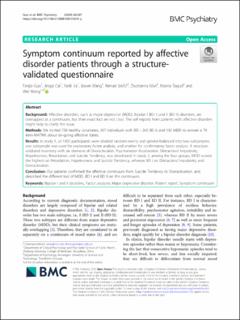Symptom continuum reported by affective disorder patients through a structure validated questionnaire
| dc.contributor.author | Guo, Fanjia | |
| dc.contributor.author | Cai, Jingyi | |
| dc.contributor.author | Jia, Yanli | |
| dc.contributor.author | Wang, Jiawei | |
| dc.contributor.author | Jakšić, Nenad | |
| dc.contributor.author | Kövi, Zsuzsanna | |
| dc.contributor.author | Šagud, Marina | |
| dc.contributor.author | Wang, Wei | |
| dc.date.accessioned | 2022-05-03T14:44:20Z | |
| dc.date.available | 2022-05-03T14:44:20Z | |
| dc.date.created | 2020-11-11T13:39:56Z | |
| dc.date.issued | 2020 | |
| dc.identifier.issn | 1471-244X | |
| dc.identifier.uri | https://hdl.handle.net/11250/2994011 | |
| dc.description.abstract | Background Affective disorders, such as major depressive (MDD), bipolar I (BD I) and II (BD II) disorders, are overlapped at a continuum, but their exact loci are not clear. The self-reports from patients with affective disorders might help to clarify this issue. Methods We invited 738 healthy volunteers, 207 individuals with BD I, 265 BD II, and 192 MDD to answer a 79 item-MATRIX about on-going affective states. Results In study 1, all 1402 participants were divided random-evenly and gender-balanced into two subsamples; one subsample was used for exploratory factor analysis, and another for confirmatory factor analysis. A structure-validated inventory with six domains of Overactivation, Psychomotor Acceleration, Distraction/ Impulsivity, Hopelessness, Retardation, and Suicide Tendency, was developed. In study 2, among the four groups, MDD scored the highest on Retardation, Hopelessness and Suicide Tendency, whereas BD I on Distraction/ Impulsivity and Overactivation. Conclusion Our patients confirmed the affective continuum from Suicide Tendency to Overactivation, and described the different loci of MDD, BD I and BD II on this continuum. | en_US |
| dc.language.iso | eng | en_US |
| dc.publisher | BMC | en_US |
| dc.rights | Navngivelse 4.0 Internasjonal | * |
| dc.rights.uri | http://creativecommons.org/licenses/by/4.0/deed.no | * |
| dc.title | Symptom continuum reported by affective disorder patients through a structure validated questionnaire | en_US |
| dc.title.alternative | Symptom continuum reported by affective disorder patients through a structure validated questionnaire | en_US |
| dc.type | Peer reviewed | en_US |
| dc.type | Journal article | en_US |
| dc.description.version | publishedVersion | en_US |
| dc.source.volume | 20 | en_US |
| dc.source.journal | BMC Psychiatry | en_US |
| dc.source.issue | 207 | en_US |
| dc.identifier.doi | 10.1186/s12888-020-02631-y | |
| dc.identifier.cristin | 1846963 | |
| cristin.ispublished | true | |
| cristin.fulltext | original | |
| cristin.qualitycode | 2 |
Tilhørende fil(er)
Denne innførselen finnes i følgende samling(er)
-
Institutt for psykologi [2886]
-
Publikasjoner fra CRIStin - NTNU [37221]

